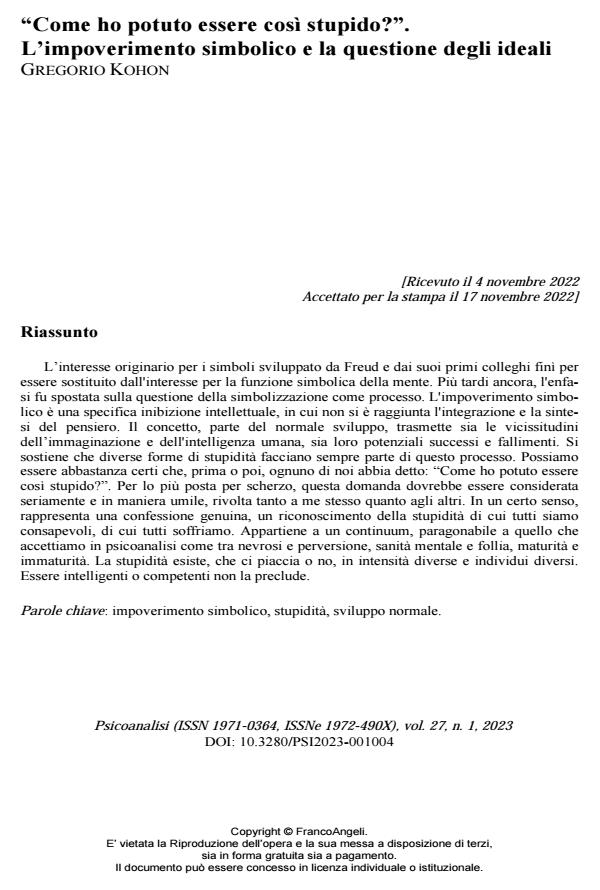"Come ho potuto essere così stupido?". L’impoverimento simbolico e la questione degli ideali
Titolo Rivista PSICOANALISI
Autori/Curatori Gregorio Kohon
Anno di pubblicazione 2023 Fascicolo 2023/1
Lingua Italiano Numero pagine 23 P. 53-75 Dimensione file 281 KB
DOI 10.3280/PSI2023-001004
Il DOI è il codice a barre della proprietà intellettuale: per saperne di più
clicca qui
Qui sotto puoi vedere in anteprima la prima pagina di questo articolo.
Se questo articolo ti interessa, lo puoi acquistare (e scaricare in formato pdf) seguendo le facili indicazioni per acquistare il download credit. Acquista Download Credits per scaricare questo Articolo in formato PDF

FrancoAngeli è membro della Publishers International Linking Association, Inc (PILA)associazione indipendente e non profit per facilitare (attraverso i servizi tecnologici implementati da CrossRef.org) l’accesso degli studiosi ai contenuti digitali nelle pubblicazioni professionali e scientifiche
L’interesse originario per i simboli sviluppato da Freud e dai suoi primi colleghi finì per essere sostituito dall'interesse per la funzione simbolica della mente. Più tardi ancora, l'enfasi fu spostata sulla questione della simbolizzazione come processo. L'impoverimento simbolico è una specifica inibizione intellettuale, in cui non si è raggiunta l'integrazione e la sintesi del pen-siero. Il concetto, parte del normale sviluppo, trasmette sia le vicissitudini dell’immaginazione e dell'intelligenza umana, sia loro potenziali successi e fallimenti. Si sostiene che diverse forme di stupidità facciano sempre parte di questo processo. Possiamo essere abbastanza certi che, prima o poi, ognuno di noi abbia detto: “Come ho potuto essere così stupido?”. Per lo più po-sta per scherzo, questa domanda dovrebbe essere considerata seriamente e in maniera umile, rivolta tanto a me stesso quanto agli altri. In un certo senso, rappresenta una confessione ge-nuina, un riconoscimento della stupidità di cui tutti siamo consapevoli, di cui tutti soffriamo. Appartiene a un continuum, paragonabile a quello che accettiamo in psicoanalisi come tra ne-vrosi e perversione, sanità mentale e follia, maturità e immaturità. La stupidità esiste, che ci piaccia o no, in intensità diverse e individui diversi. Essere intelligenti o competenti non la pre-clude.
Parole chiave:impoverimento simbolico, stupidità, sviluppo normale.
Gregorio Kohon, "Come ho potuto essere così stupido?". L’impoverimento simbolico e la questione degli ideali in "PSICOANALISI" 1/2023, pp 53-75, DOI: 10.3280/PSI2023-001004